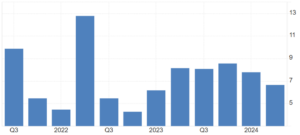
In his 2023 Independence Day address, Prime Minister Narendra Modi envisioned India as a developed country by 2047, coinciding with the centenary of independence. Since then, the government announced several schemes towards the goal of ‘Viksit Bharat’. While this vision might seem over-optimistic, recent analyses suggest that India’s economic growth trajectory, driven by strong fundamentals and strategic opportunities, makes such an outcome plausible. But the path is fraught with challenges, and India’s future prosperity will depend on its ability to capitalise on key strengths while addressing deep-rooted systemic issues.
India’s economic growth potential is immense, largely due to its population size and increasing economic activity. By 2047, India’s population is expected to surpass 1.6 billion. In terms of purchasing power parity (PPP), India’s economy could rival that of the US, particularly if current growth trends hold. Even at a conservative annual economic growth rate of 5%, India could match the US economy in size by mid-century. This would cement India’s status as a global economic power, though disparities in productivity and technological prowess would remain.
India annual GDP growth (%)

However, achieving parity with high-income nations on terms of per capita GDP is a far steeper climb. India’s per capita income is way behind that of advanced economies, and catching up would require sustained economic growth of over 7% annually — comparable to China’s meteoric rise from 1990 to 2012. While this pace is historically rare, it shows the scale of reform and innovation required to uplift the living standards for all Indians.
READ I Kerala must focus on entrepreneurship for growth
Exports key to economic growth
A critical driver of this transformation will be exports which have historically played a pivotal role in India’s economic expansion. Despite misconceptions that exports have been secondary to India’s growth, they are vital for several reasons. Exports help finance essential imports, boost competition, and facilitate access to global technology and know-how. Yet, India’s global share in merchandise exports remains modest at just 2.2% in 2022, dwarfed by China’s 17.6%. Even in services, where India holds a competitive edge, its share of 4.4% is far below that of the US and China.
Exports from India sink 9.3% to $34.71 bn

To sustain rapid growth, India must significantly boost its export share in global markets. This will require overcoming structural challenges, such as low labor productivity in manufacturing and stiff competition from nations like Vietnam and Bangladesh. Fortunately, India has advantages — its strategic relationships with the West, a dynamic diaspora, and its positioning as a ‘China plus one’ alternative for multinational corporations seeking to diversify their supply chains.
India’s ability to lead trade liberalisation efforts, both domestically and globally, will be critical. It must deepen integration into global supply chains, reduce tariff barriers, and foster an investment-friendly environment that encourages both domestic and foreign participation in high-growth sectors.
Education, infrastructure, investment
While external engagement is crucial, India’s success will largely be determined by how it manages its internal challenges. There is a need for improvements in education, infrastructure, and governance to sustain high growth rates. India must prioritise upgrading its education system to build a workforce capable of navigating an increasingly digital and automated global economy. Simultaneously, the development of robust physical infrastructure is essential to support industrial expansion and urbanisation.
The government’s post-pandemic fiscal and monetary policies have laid a strong foundation for future growth, helping to stabilise the economy amidst global disruptions. India’s GDP growth, averaging 6.6% from 2010 to the pandemic, has proven resilient, and forecasts from organisations like the World Bank, IMF, and OECD project growth to rebound to 7% by 2024-25. However, employment growth has lagged behind, with many new jobs concentrated in low-wage sectors. To ensure equitable development, India must focus on creating high-quality jobs, especially in sectors like technology, clean energy, and advanced manufacturing.
Investment — both public and private — will play a crucial role in sustaining growth. Public investment in infrastructure is already yielding positive results, but private investment remains essential for innovation and long-term growth. The government must also foster a more conducive environment for investment by simplifying regulatory frameworks, addressing legal bottlenecks, and ensuring policy stability.
Harnessing technology, youth power
India’s demographic dividend is often cited as a key advantage. With a strong middle class and a rising consumer base, domestic demand will remain robust. But to truly realise its potential, India must invest heavily in new technologies like artificial intelligence (AI), quantum computing, and blockchain, which are poised to reshape industries. Reports suggest that these innovations could boost India’s market capitalisation to $50 trillion by 2047.
This technological leap forward will require substantial investments in research and development, as well as policies that encourage startups and foster digital transformation across sectors. AI and machine learning, in particular, hold the potential to revolutionise governance, finance, and supply chains, making India a leader in market transparency and efficiency. However, the shift towards automation and AI could also displace millions of low-skilled workers, underscoring the need for robust social safety nets and upskilling programs to ensure inclusive growth.
Tackling global disruptions
Global economic conditions present additional hurdles. The IMF’s World Economic Outlook 2024 warns of a slowdown in global growth due to demographic changes and protectionist policies, particularly in the US and Europe. Rising protectionism, coupled with geopolitical tensions and the looming climate crisis, could threaten global trade dynamics, upon which India’s export-driven growth relies.
Yet, India is uniquely positioned to navigate these challenges. As a connector country in the global economy, India’s strategic importance is growing, particularly as the world looks for alternatives to Chinese dominance. Moreover, India’s leadership in clean energy transitions, bolstered by its commitment to sustainable development, could unlock new growth opportunities in green technologies and renewable energy sectors.
India’s journey to becoming a developed nation by 2047 is both plausible and fraught with complexity. On one hand, India’s sheer size, demographic potential, and strategic position in global trade offer a powerful foundation for growth. On the other hand, the country must overcome significant domestic challenges — improving education, upgrading infrastructure, fostering innovation, and ensuring inclusive development. Moreover, global uncertainties, from slowing growth to climate change, pose additional risks.
Anil Nair is Founder and Editor, Policy Circle.

